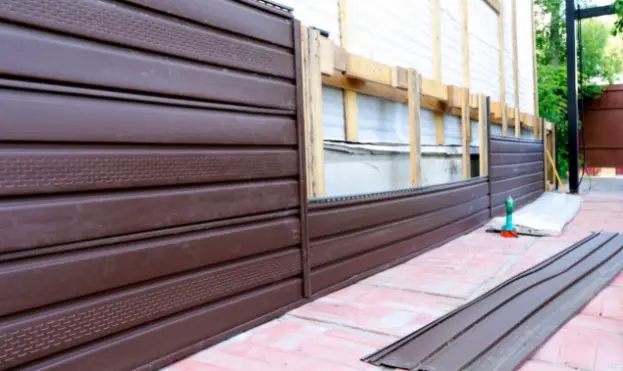Do You Have Questions About Siding Services? We Have Answers
 Siding is basically what makes up the majority of your home's exterior. While it's aesthetically pleasing, it also serves to protect your home from the elements, changing temperatures and moisture damage. Siding comes in a range of styles and materials, each with its own set of advantages and disadvantages. Likely, you already know what kind is on the exterior walls of your home. But if you're not sure, building a new house, or renovating, here's a rundown of the most common types.
Siding is basically what makes up the majority of your home's exterior. While it's aesthetically pleasing, it also serves to protect your home from the elements, changing temperatures and moisture damage. Siding comes in a range of styles and materials, each with its own set of advantages and disadvantages. Likely, you already know what kind is on the exterior walls of your home. But if you're not sure, building a new house, or renovating, here's a rundown of the most common types.
What are the Different Types?
- Stucco: A mixture of cement, lime, and sand, this material is quite common on new-builds. It has insulating qualities, lasts a long time, and can be textured for a unique appearance. Stucco is also available in a range of colors.
- Vinyl: This material is also a very common variety. It's made out of a type of plastic called PVC (polyvinyl chloride). Vinyl is very durable and lasts a long time, but it can be bleached in the sun.
- Fiber Cement: This material is also man-made, and consists of cement, sand, water, and cellulose fibers. It's usually made to mimic the appearance of wood.
- Aluminum: This material is highly durable, provides excellent insulating properties, and can help reduce heating and cooling expenses. Aluminum can even be painted in many colors.
- Wood: This is the most traditional cladding material, but is less common in new-builds. Many types of wood can be used; like cedar or pine. Wood is very versatile, is available in a variety of styles, and creates a natural look. But, its main drawbacks are that it can have problems with wood rot and water damage.
- Composite/Engineered Wood: This material is made of various fibers and strands that are combined to look like authentic wood while actually only using a small amount of real wood. Thus, engineered wood costs less than real wood, but looks like the real thing.
- Brick: One of the most classic types of siding, brick has a truly timeless aesthetic. But, it requires a mason to properly install it and has a higher installation cost than other materials.
- Stone: Natural stone materials are those sourced out of a quarry. Usually, this includes limestone, granite, and slate. Stone lasts a long time, does not require a lot of maintenance, and is very beautiful to look at. But it's generally much more costly to install.
What Issues Do I Have to Watch For?
Although some types of siding are more resilient than others, each material needs to be properly maintained. It's important to promptly repair or replace damaged cladding so that the issue does not worsen or spread to your home's supports. Also, your neighbors will thank you for keeping your home looking great all year round. There are many warning signs that your cladding has seen better days. If you notice any of the following, call the improvement professionals at My Handyman of Ann Arbor, Saline, and Chelsea.
1. Buckling & Warping
Wood and vinyl siding are two of the most popular types of cladding. One being more traditional, the other a relatively newer design. But the biggest difference between the two is how each material is adhered to your home. Wood is nailed directly down to the sides of your house, leaving no wiggle room. But vinyl siding is attached with fasteners, leaving a small space. This is because vinyl contracts and expands as temperatures change. If your vinyl siding was attached too tightly, it will buckle and warp as it tries to move.
2. Cracking & Bending Under Pressure
Although most varieties of cladding are designed to withstand a certain amount of pressure—after all, they do protect your home from the elements—they can still be damaged from time to time. Heavy, fast-moving objects can damage your home's exterior. For instance, hail during a storm, rocks expelled by a lawnmower, falling tree branches, and golf balls can all cause damage.
No matter how extensive the damage, it's very important to fix any chips, cracks, or dents in your siding as soon as possible. These weakened areas could get worse, creating multiple headaches like structural damage, leaks, mold, and wood rot.
3. Issues with Flashing
Also known as waterproofing, flashing fits around areas of your siding where water might get in. Usually, it's found in places where cladding joins the roof. Flashing is made out of a thin sheet or strip of water-resistant material (usually galvanized steel). If it's installed incorrectly, water could leak into your siding and cause rot, mold, and other problems.
4. Moisture Penetration
One of siding's main functions is to protect your home from water damage. But, most siding materials are not entirely waterproof or impervious to moisture—especially when damaged or installed incorrectly. Water can seep through even the smallest dents and cracks. Once it does, the moisture will spread throughout your home's structural supports. This can cause significant and visible water damage, mold buildup, and wood rot.
5. Wood Rot, Mold & Mildew Growth
Water damage causes mold, mildew, and possibly wood rot to spread through your siding and home. These issues are very serious, as they can cause structural and health-related problems. The best way to safeguard against problems with your cladding is to inspect it one to two times a year. Walk through your property in both the spring and fall, checking for issues. Be sure to look for:
- Algae, which usually looks green, brown, or black
- Mold and mildew which may appear like a gray or white powder sprinkled with black specks along the sides of your home
- Wood rot, which could be softwood, discolored areas, or wood that is splintering
Be sure to check for signs of damage in the following high-risk areas:
- Beneath gutters and drainage systems
- Shaded areas where shrubs or trees cover the walls
- Areas around washing machines, vents, and other appliances
Where Can I Hire Siding Services?
It's important to take care of your siding so you can avoid costly repairs and replacements in the future. To help you keep your cladding looking as good as the day you moved into your home, the team at My Handyman of Ann Arbor, Saline, and Chelsea provide extensive repair, installation, and maintenance services. We have decades of experience and expertise to solve a multitude of problems, ensuring the job gets done right the first time—every time. Our team offers reliable solutions you can trust.
To book an appointment or to inquire about our full range of services, we invite you to call our friendly customer service representatives. You can also contact us online by submitting a service request form.
 Click to call
Click to call


